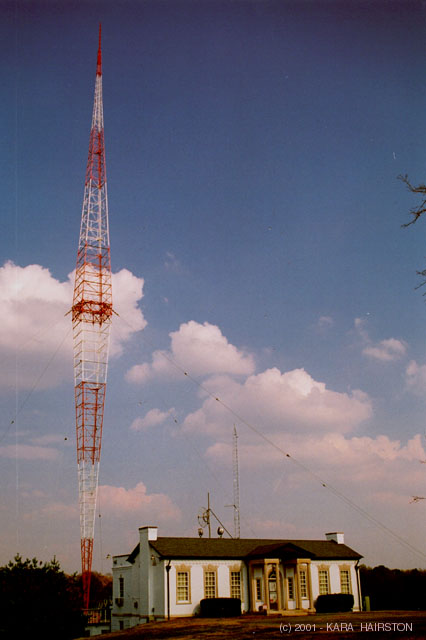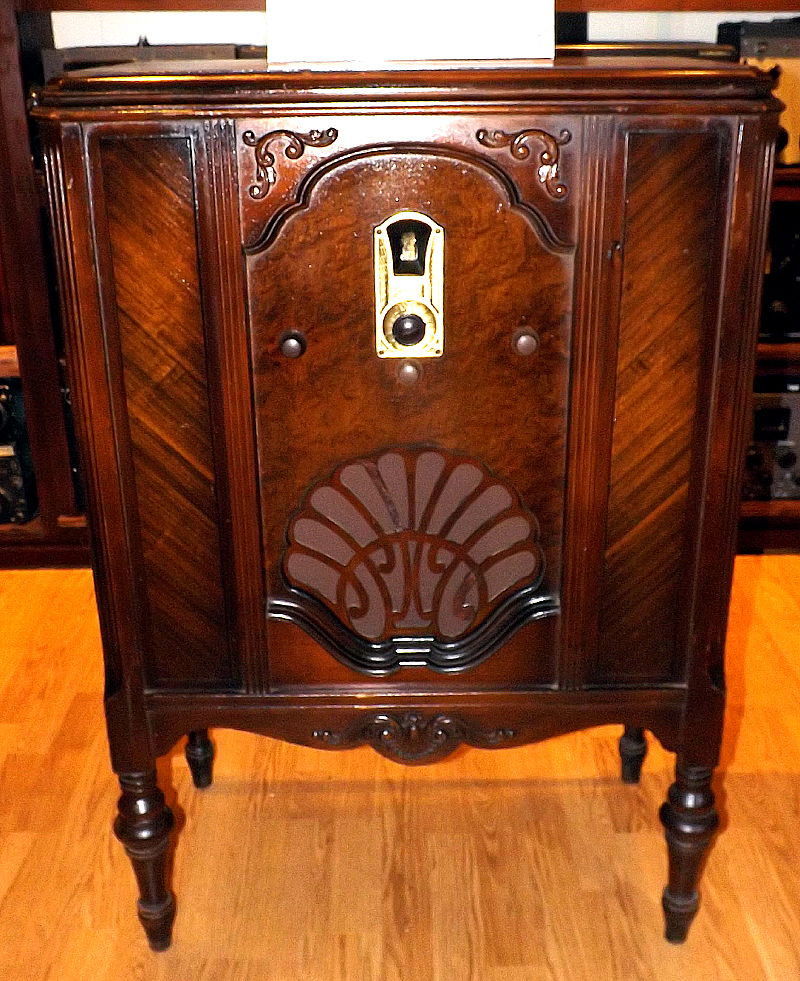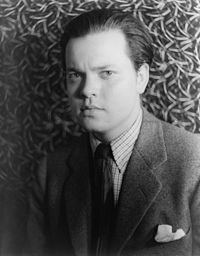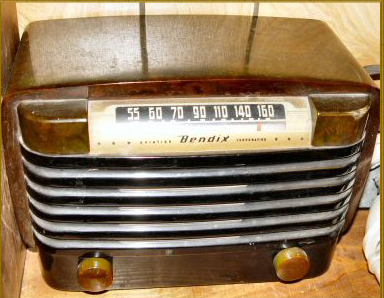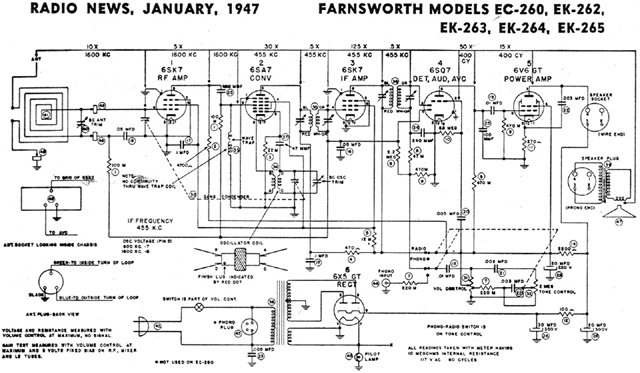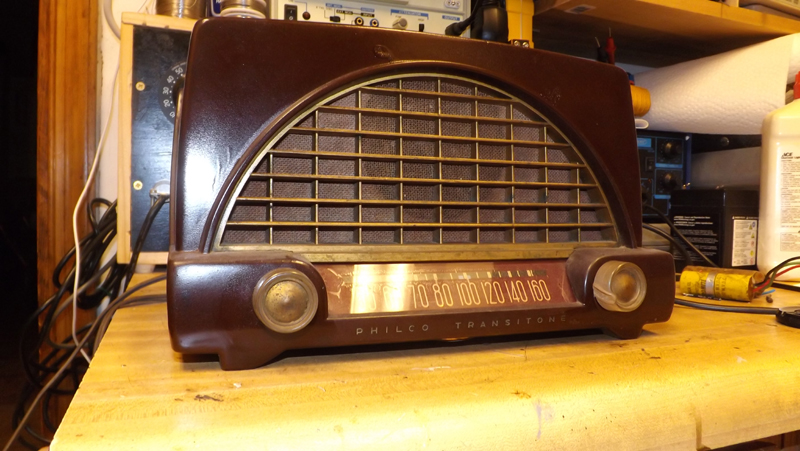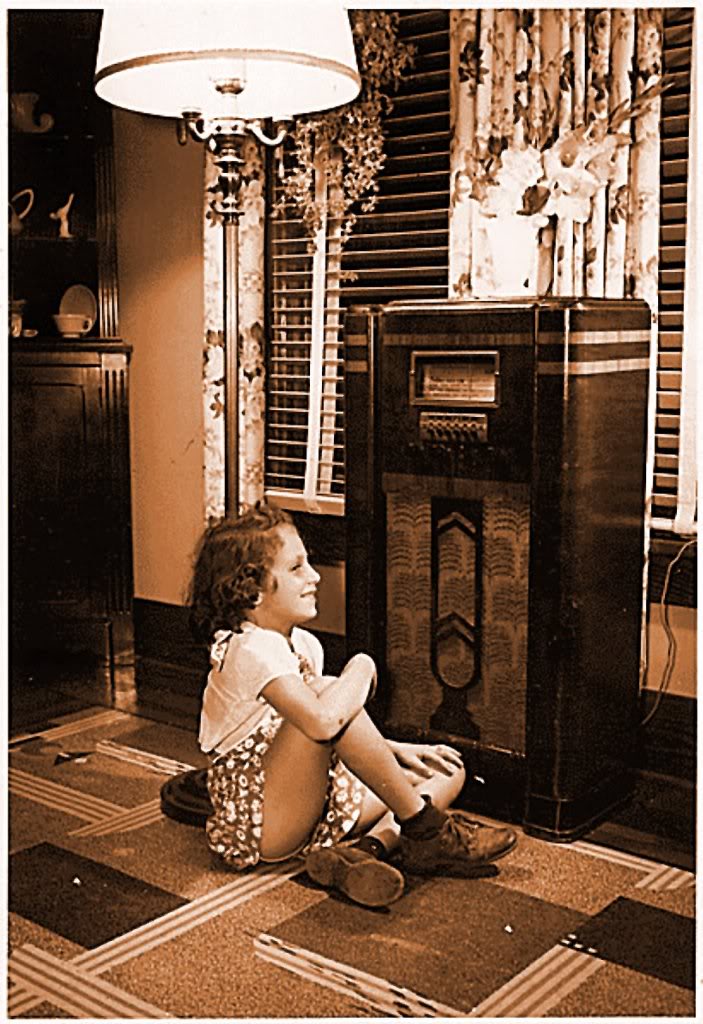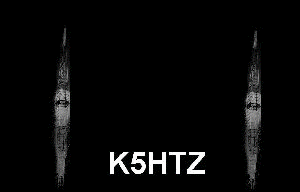 |
Radio Related Links |
from OTR.net |
|
| MUSEUM OF YESTERDAY |


 DEPRESSION AND
DEPRESSION AND 
PRE-WAR ERA HOME RECEIVERS
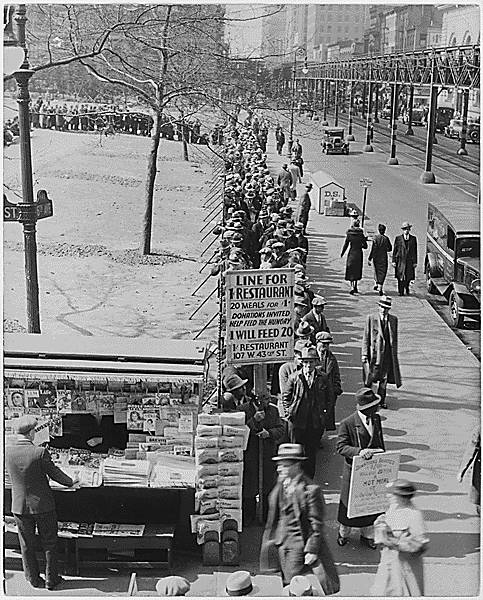
 |
The onset of the Great Depression saw an end to many of the practices that individuals and families enjoyed in the prosperous 1920s. Motion picture and supper club entertainment had became an unaffordable luxury for many. Persons in rural areas were now isolated because of the cost of even short distance travel, so the new invention of the Radio, and its introduction into the home, seemed to be a cost-effective alternative to public places of entertainment. For the typical American family of the early 1930s, a superhetrodyne radio receiver in the home brought in news of the world. Through this relatively inexpensive home appliance, families in places such as rural West Virginia, could listen in on what was going on with their counter-parts in places like New York, Washington D.C., San Francisco, Detroit, and even foreign countries. Radio melted down the cultural divides between geographic locations, and carried desperate folks through the worst depression in the Nation's history followed by the great "War to End All Wars." In studying the history of civilization in the United States, the Railroads are generally credited with having shaped the American landscape, but it was Radio that brought America together and formed the cultural bonds between Americans from all walks of life. Through the programs that Radio brought into the home, every listener could learn from and identify with his neighbors in every corner of the nation. In this gallery, we celebrate the Depression Era home radio, the one device responsible for keeping the sanity of a nation through almost two decades of financial despair and world turmoil. |
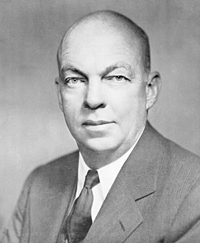 Major Edwin Armstrong |
While Dr. Lee DeForest was credited with the discovery or invention of the vacuum tube, court testimony in later patent infringement cases determined that DeForest did not totally understand the operation of his own invention. This came to light when another inventor and engineer, Major Edwin W. Armstrong began to employ DeForest's discovery in the construction of practical radio receiving apparatus. Armstrong first designed the Super-Regenerative receiver which employed an amplified feedback scheme, using the Audion, to boost signals to the point where they could be easily heard on earphones, or amplified for use with a loud speaker. Most of the early 1920s radios employed this technology, many with multiple stages and an array of dials which made use and tuning difficult. By the late '20s, Armstrong had come up with a more practical receiver which he called the "Super-hetrodyne." This system used a local oscillator beating against the incoming signal, which formed an intermediate or IF signal that could then be detected and amplified by additional stages. The resulting sets only required one tuning dial, which simplified operation and made the receivers highly stable and dependable for home use. The receivers shown in this section of the museum employ Armstrong's Super-Hetrodyne technology. This improvement in receiver technology is really what enabled the purchase of home radios take off in the early years of the Great Depression. Major Armstrong gave us many of radio's improvements and innovations such as FM reception and even early television technology. His life was spent in almost constant lawsuits with David Sarnoff of RCA, who seemed to be bent on Armstrong's destruction. This rivalry ensued after Armstrong refused to sell his patents to RCA. While DeForest, Armstrong and Sarnoff are all considered pioneers of modern radio, Armstrong held the distinction of having been the first inventor to bring his products to the finish line. Unfortunately, after loosing a number of battles in the courts with Sarnoff, Major Armstrong, now penniless, tragically ended his own life by stepping out of an eighth floor window and falling to his death. |
 |
By the early 1930s, Radio had established itself as a welcome news, entertainment and information fixture in many American households. While few, at the time, realized what went into making Radio happen, this 1930s video by Chevrolet division of General Motors, explained in words and pictures, what went into a typical radio production. To see the video, click the button below. |

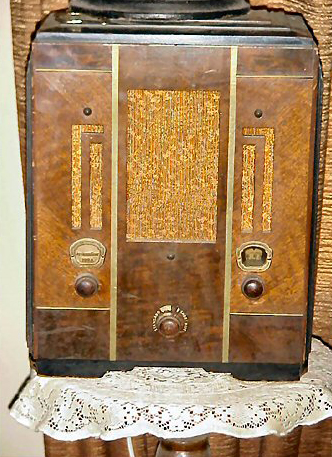
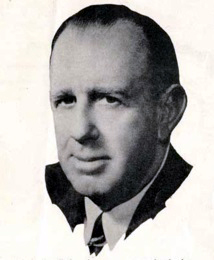 |
Powel Crosley, who was a 1920s manufacturer of after market automobile accessories, was introduced to radio by his father. Crosley soon became interested in the new medium and decided to expand his company's product line to include radios and radio parts. Shortly thereafter, Crosley decided that he needed to make interesting content available for the purchasers of his radios, so he founded radio station WLW, known as "The Nation's Station" and based in Cincinnati. Beginning with a 5 watt transmitter in his home, the station evolved over time, and in the years prior to WW-II, Crosley was able to obtain FCC permission to operate the only 500KW AM radio station in the United States. Crosley died in 1961, but today, the Crosley name has been licensed to foreign manufacturers and appears on many "replica" radio products. While this gallery features Crosley's "Depression" models, earlier Crosley sets are shown in the 1920s battery radio listing in the previous gallery. |
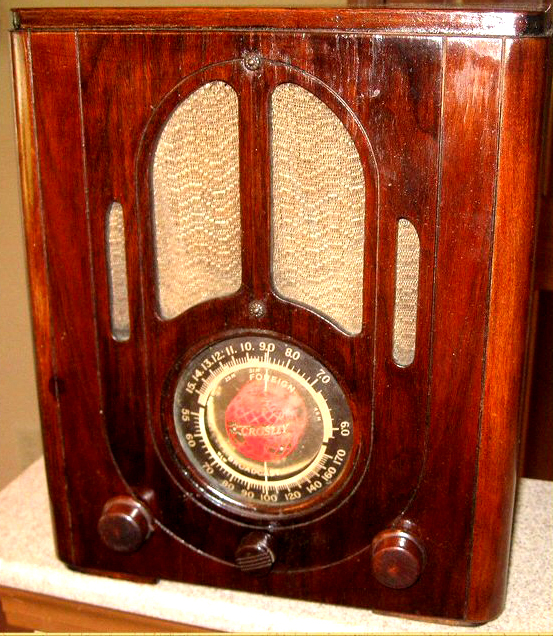
1937 Crosley "FIVER" Table-Top Radio Model 547 was Crosley's "cost cutting" set for the later Depression years. Based on other "tomb stone" radios that preceded it, Crosley had cut a few corners in the design of this radio in order to allow a reliable table radio at an even lower selling price for a Depression plagued nation.
An interesting side note: When the Museum of Yesterday obtained this radio for our collection, only minimal repairs were needed to bring it to full restoration. The set was still functioning with all of its original and nearly 80 year old Crosley brand vacuum tubes, and only minimal wax capacitor replacement was required to bring it back to full reliable working condition. Just try to get that degree of longevity from even an expensive modern day radio.
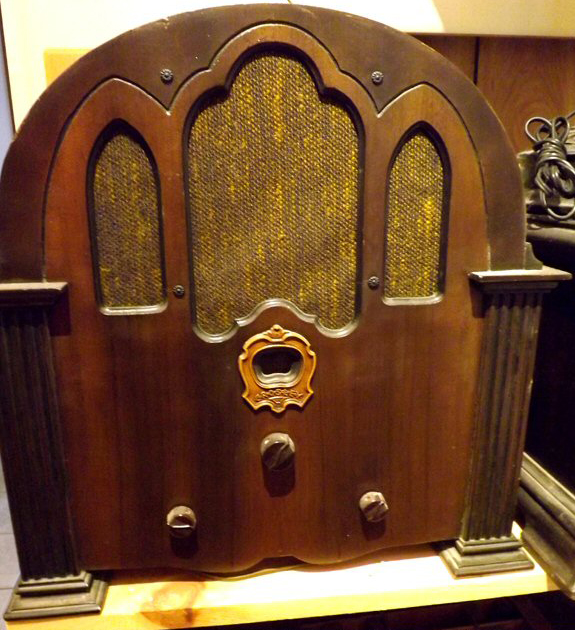
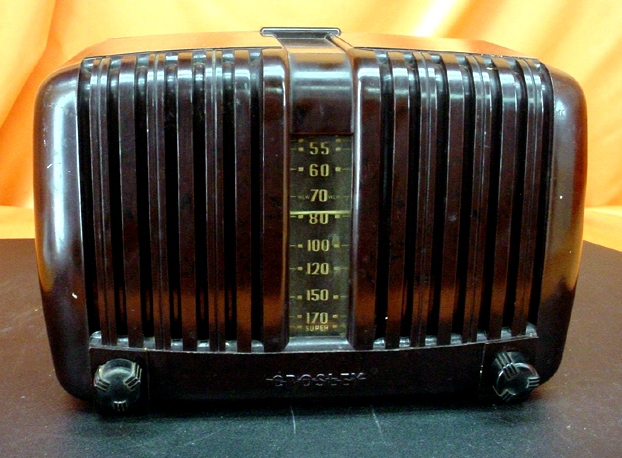
A personal recollection from museum founder:
The Crosley Model 6519 is another radio from my past. My father had a one of these in the workshop / laboratory of our Gentilly Terrace home back in the late 1940s. It was a present that he had received from my mother, who was his fiancee at the time, upon his graduation from Tulane University College of Engineering in 1938. With a great deal of care on his part, the set had made it through the war years, and it was still functioning perfectly when my parents moved into their own home in 1946 after the war had ended.
My dad and I usually listened to the little Crosley radio, in the shop, when we were working on Saturday morning projects back in the late '40s and early 1950's. The Saturday morning radio lineup in that era included shows like "Galen Drake," "Let's Pretend" "The Mary Lee Taylor Program." on the network stations, Later at mid-day, we would switch to one of New Orleans' pioneer local independent stations, WJBW "studios in the Cigali Building," for their local DJ show known as"Spinn Inn."
In several formative phases of my life, Radio played an important role, as all of the members of my family valued their radios and the favorite shows to which they listened. Thus, time spent with family usually involved radio in some way

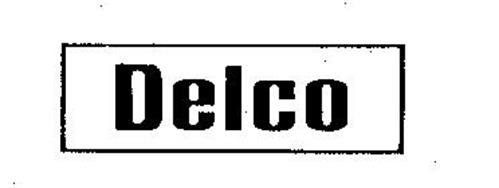
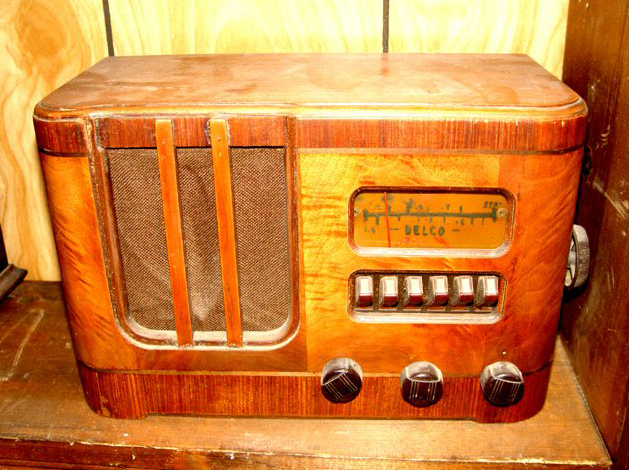

This Emerson wood cabinet table radio from the mid-1930s is an indicator of changing cabinet styles.
Although Emerson Electric was primarily a manufacturer of fans and motors, the company was actively involved in the production of radios and phonographs during this era. Emerson entered the home entertainment radio market later than most Cathedral style radio makers, but they did have a number of models available prior to the 1941 manufacturing blackout.




On September 25, 1928, Paul V. Galvin and his brother, Joseph, incorporated Motorola’s founding company—the Galvin Manufacturing Corporation in Chicago, Illinois. |
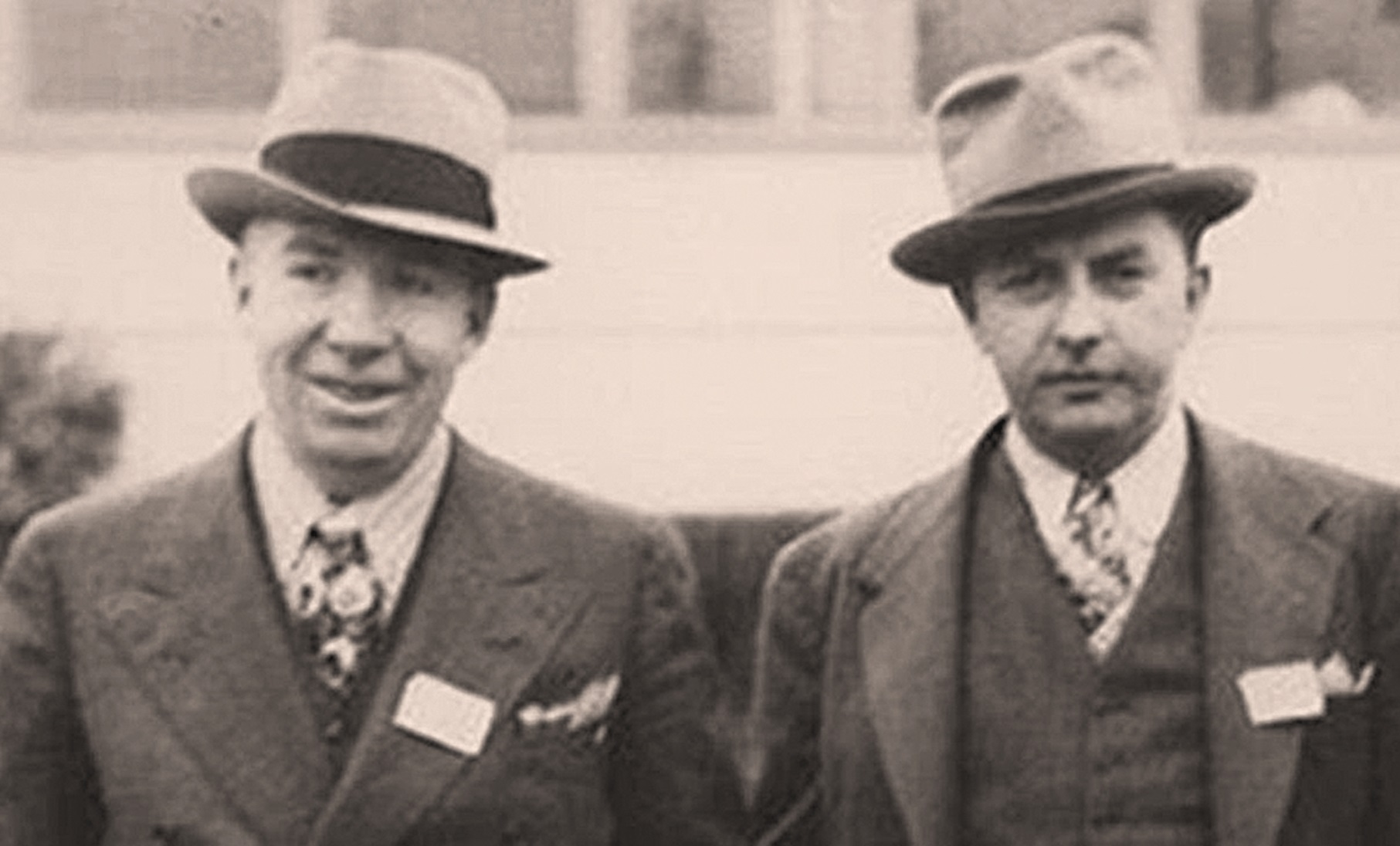 |
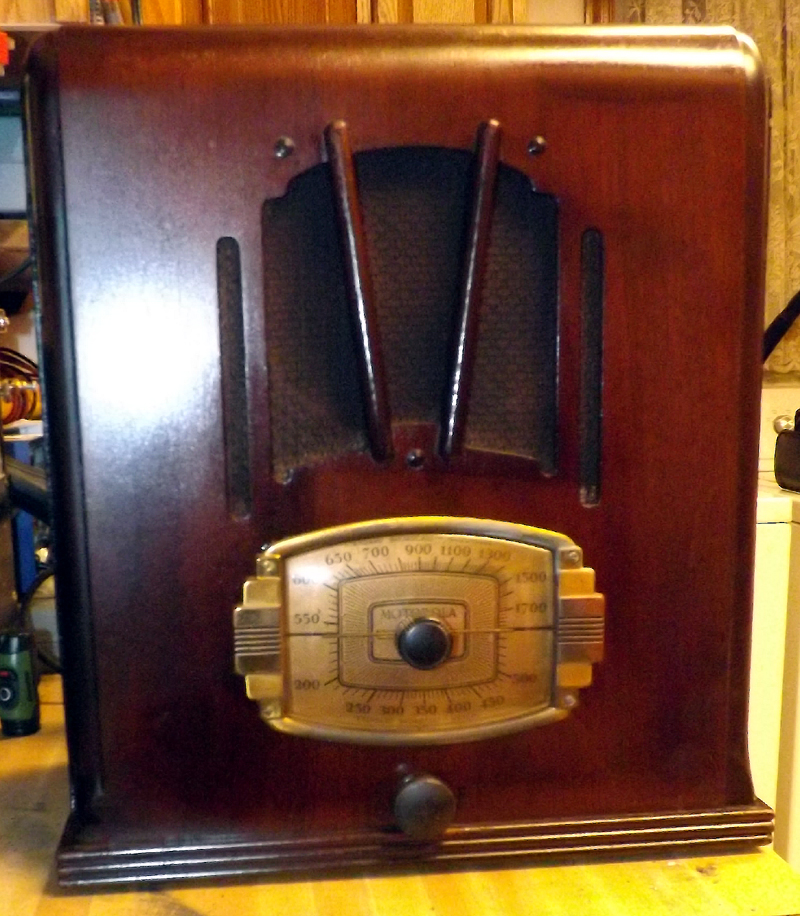
A LEADING MANUFACTURER OF DEPRESSION ERA RADIOS
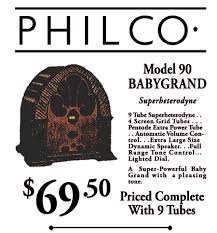 |
Philco's line of Depression Era "Cathedral" and "Tombstone" Radios were trend setters in the 1930s Their reasonable price structure placed them in the reach of many financially strapped families. |
Philco Model 87 radio was an early set designed for exclusively 110 volt AC operation. This chassis design of home receiver, which saw many cabinet variations, represented the transition between battery era radios and the advent of plug-in sets that began about the year 1929. While Philco was a leader in the market, several other manufacturers were following this design concept in that same era. The museum recently acquired this Model 87 set, shown here in its completely restored state, as a replacement for our previous Model 87 which was lost in the New Orleans Katrina flood of 2005.
While console radios were manufactured well into the 1950s, and they actually saw a resurgence just prior to World War II. The early years of the "Great Depression," and the financial restraints brought on during that period, placed elaborate consoles out of the reach of most American households. This fostered the development of a new, more economical player in the radio market known as the "Cathedral" or "Tomb Stone" table top radio.
If you would like to follow along with the restoration of the Model 87 as it went through the museum's restoration shop, we have provided some glimpses of the restoration processes that were employed.
Click HERE for an article and photos of the replacement of the set's capacitor bank.
Cabinet restoration Click Here
To see a short video of the completed set in operation, click here
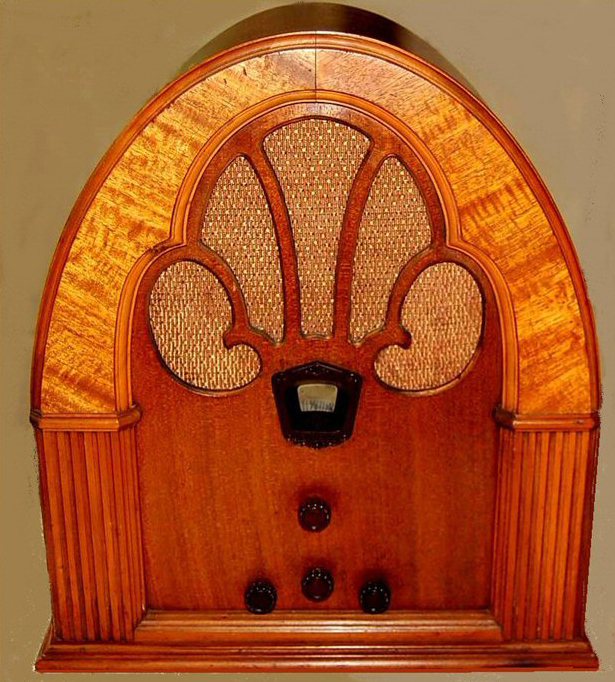
The 1931 Philco Model 70 is considered the "mother" of all depression era cathedral radios. Manufactured by the Philadelphia Storage Battery Company, which later was acquired by Ford Motor Company, these sets were among the first radios to utilize the simpler "superhetrodyne" circuitry developed by Major Edwin Armstrong, and combined that with mass-production techniques that allowed the radios to be sold at a price that even a depression era household could afford.
Today, the Philco Model 70 has become an icon representing the depression era cathedral radio spirit of wireless collecting. This beautiful example was only recently acquired by the Museum Of Yesterday, and is a proud addition to our collection. Shown below, the rear of the set illustrates the simple array of components that set the stage for the design of most table radios built before World War II.
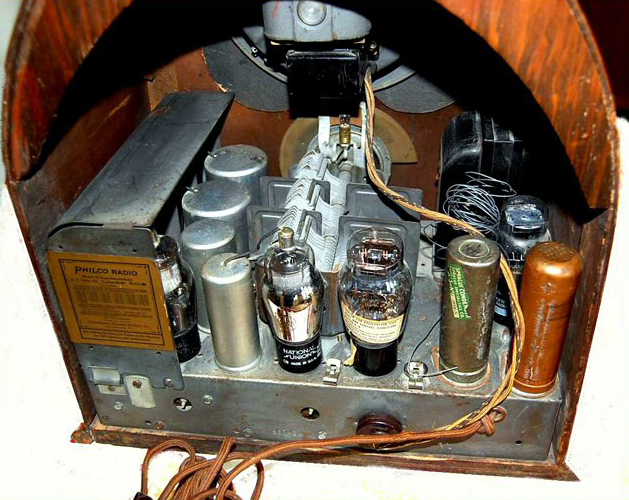

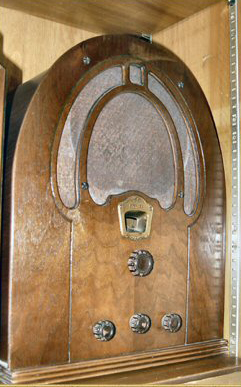
 |
 |
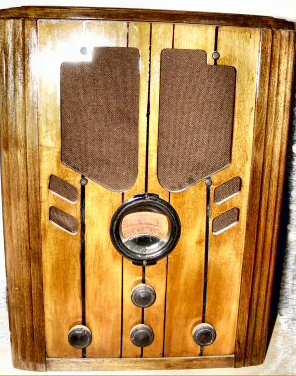
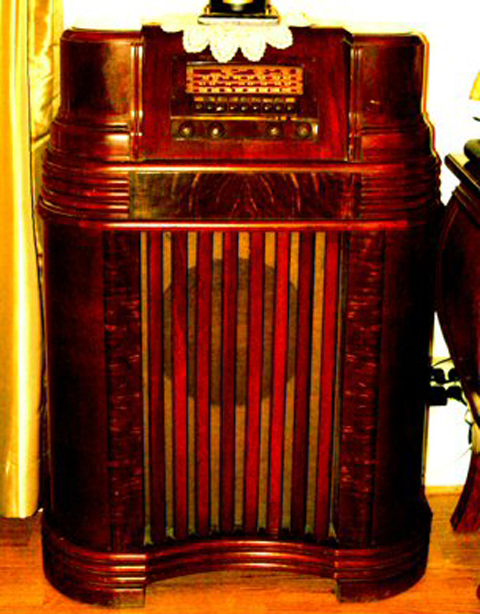
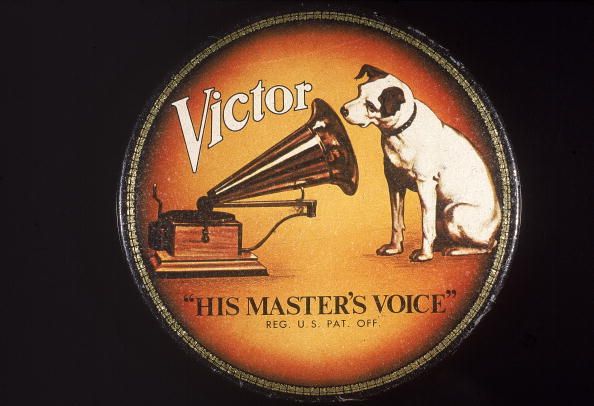 |
A descendant of the Marconi Wireless company Of America, the United States division became Radio Corporation Of America. Through the history of Radio, RCA was a pioneer in radio, communications, television and home appliances. The company also operated divisions that manufactured parts and broadcast station equipment. Although it later became a company in its own right, the National Broadcasting Company was also born under the corporate banner of RCA. |

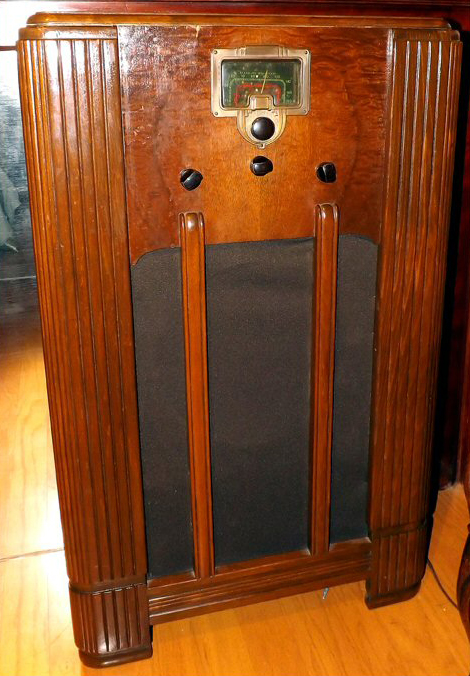

Beginning in the very early days of radio, and continuing into the latter part of the 20th Century, Chicago based Sears Roebuck and Company sold an extensive line of radios, radio accessories, and later television and entertainment music products. While Sears never actually manufactured any of the radio products it sold, Silvertone, and the Silvertone WLS associated line, were Sears official brandings for its electronics products throughout the company's history. WLS stood for World's Largest Store, and that became the call letters of the Chicago based radio station owned by Sears. The station first went on the air as WBBX, then changed to WES and later to WLS, and its original purpose was to serve listeners who were on farms or in the agricultural industry, and didn't have access to information from urban radio stations..
As far as historians have determined, Sears radios were made by at least 36 separate manufacturers over the years. Before WW-II, the main sources were Stewart-Warner, Detrola, Noblitt-Sparks(Arvin), and Warwick. After the war, Sears had contracted with Arvin and Warwick as the two major suppliers, however Philco was known to have produced some of Sears tube based automotive radios. Later, Japanese manufacturers such as Toshiba began producing Silvertone branded electronics, and Sears even marketed a home electronic organ that was made by the Thomas Organ Company.
In recognition of Sears-Roebuck Company's contribution to the history of radio, the museum has acquired a Silvertone Model 1808 (1935) "sky scraper" depression era tombstone radio as an addition to our vast communications collection. Interestingly, the Model 1808 is a battery powered set that was intended for use on farms and in rural homes where commercial electricity had not yet become available. Photos below are before and after the restoration of our 1808 model set.
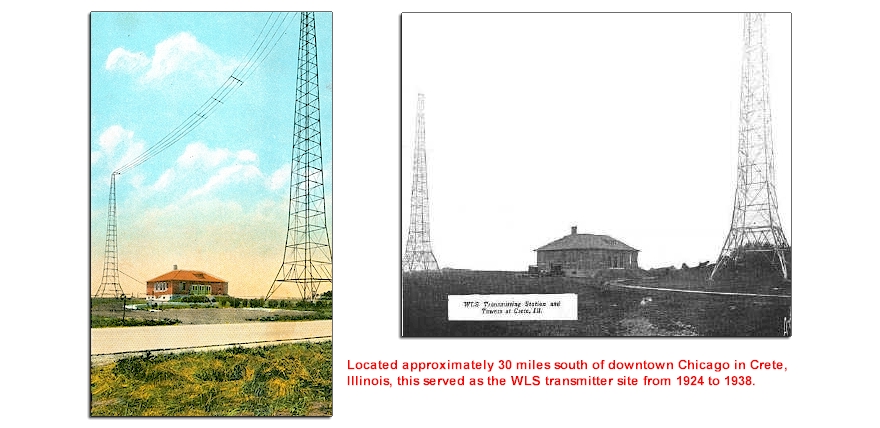
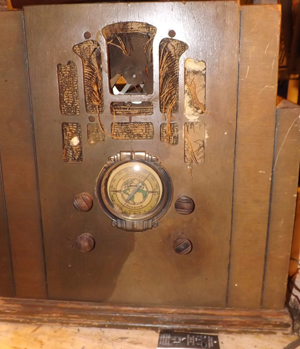 |
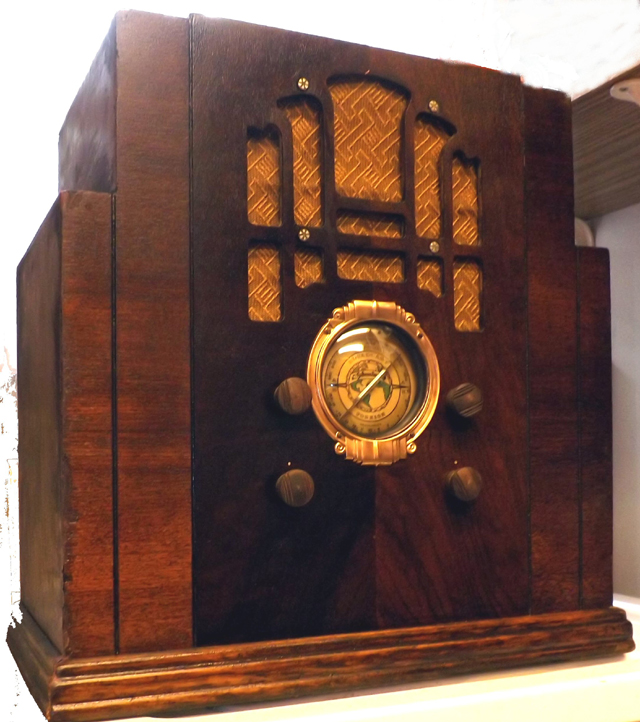 |
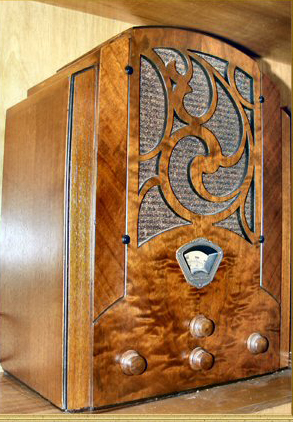


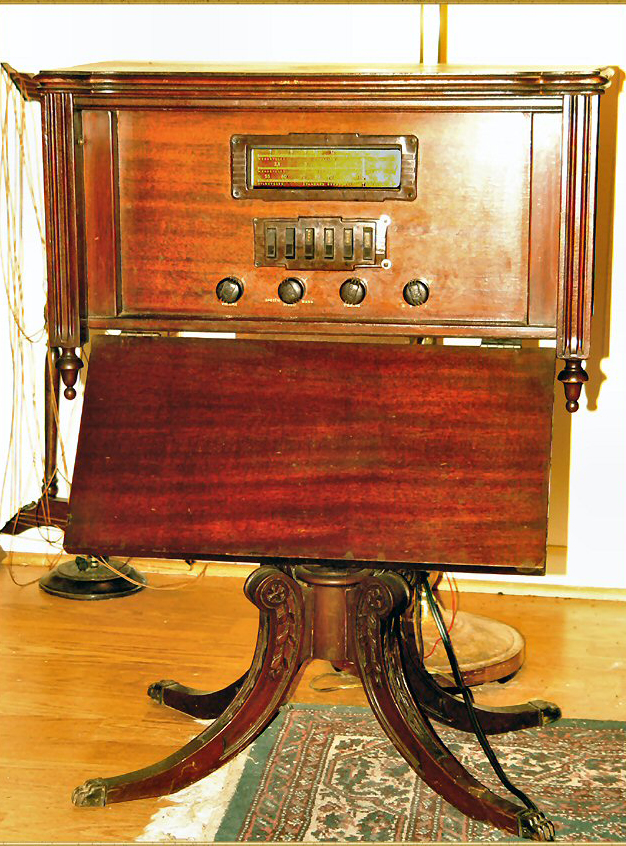
A personal recollection from museum founder and chairman John DeMajo:
This set has particular significance to me because my grandfather owned an identical set back in the late 1940's. Every day, in the pre-television era, he would fire up the set in the afternoon to listen to Stella Dallas, Gabriel Heatter's commentary on the news, and Sergeant Preston of the Yukon (Challenge Of The Yukon), but his favorite show was One Man's Family, which was at that time an early evening serial that ran for over 30 years on radio.
Although there were a large number of Stewart-Warner sets made with the O1 chassis, this particular Duncan Phyfe design cabinet is quite rare.



Founded by Alfred Stromberg and Androv Carlson, Stromberg-Carlson was one of five companies that controlled the manufacture of telephone equipment up until the end of World War II. In 1894, when Alexander Bell's patent expired, Stromberg and Carlson, who were employees of AT&T, invested $500 to form their new company. While the company's primary business was telephone related, the popularity of radio brought it into the home entertainment business. In later years, the company's attention was turned toward a scanning printer that it developed for the Social Security Administration. The name was finally sold to an Argentinian company that manufactures MP3 players and GPS equipment..
 WESTINGHOUSE
WESTINGHOUSE
This Westinghouse WR-12X8 is another pre-war table-top radio made in late 1941 as part of what would have been the 1942 product line. While the sets were introduced and sold in the fall of 1941, they are extremely rare due to the fact that manufacturing of 1942 model radios ceased with the bombing of Pearl Harbor in December of 1941, so only a limited number had been produced and sold..


Commander Eugene F. McDonald, founder and CEO of Zenith Radio Corporation
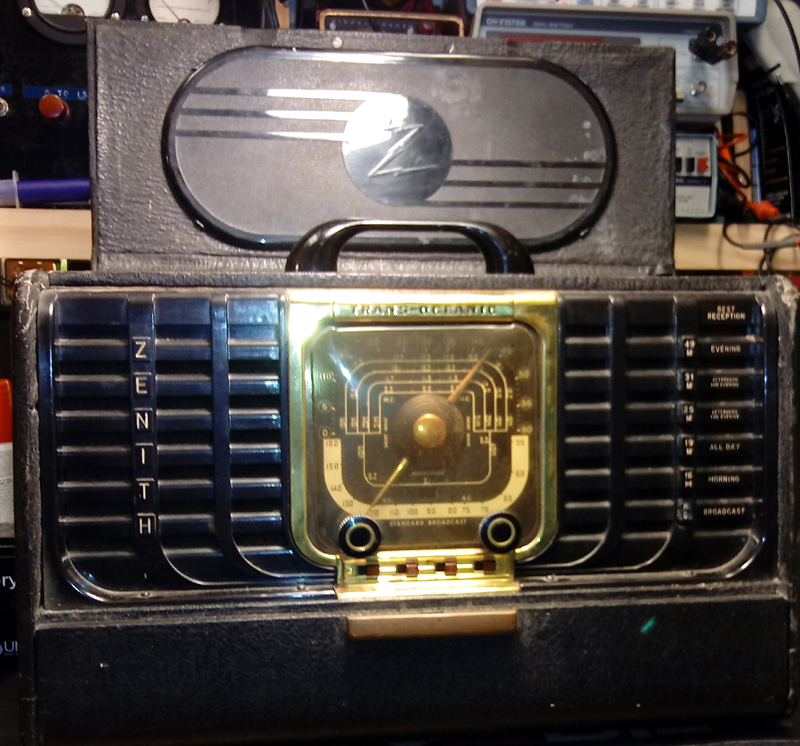
There were several generations of this type of Zenith radio ranging from 8 pin "loctal" tubes to transistors. The museum collection contains two TransOceanic sets, both from the 1946-1950 tube era. Our "post-war" Model 8G005 is shown above, and we also have a model G500, which uses miniature seven pin tubes. The tube linup on these radios was made up of tubes with 1.5 volt filaments.
The history of the Zenith TransOceanic, as written by Denny Sanders, can be seen here.

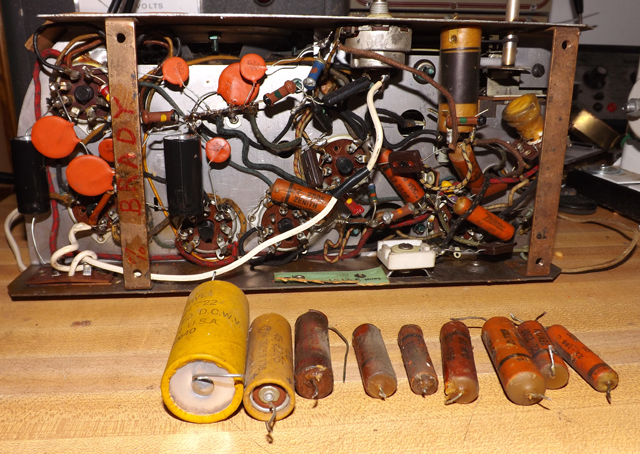
 |
One of the most important steps in the restoration of any old AC powered radio, is the replacement of capacitors that fall within the set's B+ or high voltage power chain. Capacitors, such as the paper and wax examples from the Zenith radio above, dry out and fail over time. The average life expectancy of these parts was about 20 years when the sets were manufactured. Attempting to power up an old radio without first "recapping" (replacement) of these critical components, can result in destruction of irreplaceable parts such as rectifier tubes, power transformers and speaker field coils. Applying voltage to an untested radio can also result fire or injury if a component fails violently. Do not rely on instrument checks of capacitors where B+ voltages are concerned because parts which check OK on the tester, can still fail under load when high voltages are applied. Besides Electrolytics and capacitors exposed to high voltages, another critical capacitor replacement is the audio coupling capacitor. Failure or severe value change in this component over time, can result in high voltage being dumped onto the grid of the audio output stage, resulting in damage to the tube from overheating. One other tip: always be sure to replace capacitors with not only the same value as the original, but also an equivalent working voltage rating. Capacitors sold in places like Radio Shack stores, are usually rated for today's low voltage solid-state projects. Voltages in old tube radios can often exceed 400 volts DC, so make sure you obtain replacement parts that meet or exceed the full specifications of the original parts. Capacitors designed for use in old radios are hard to obtain locally, but mail order houses such as Antique Radio Supply in Tempe, Arizona, have ample supplies of restoration quality components. The old professor's rule here is to "play it safe" and replace any wax or paper capacitors that are exposed to the radio's line or B+ voltages. |
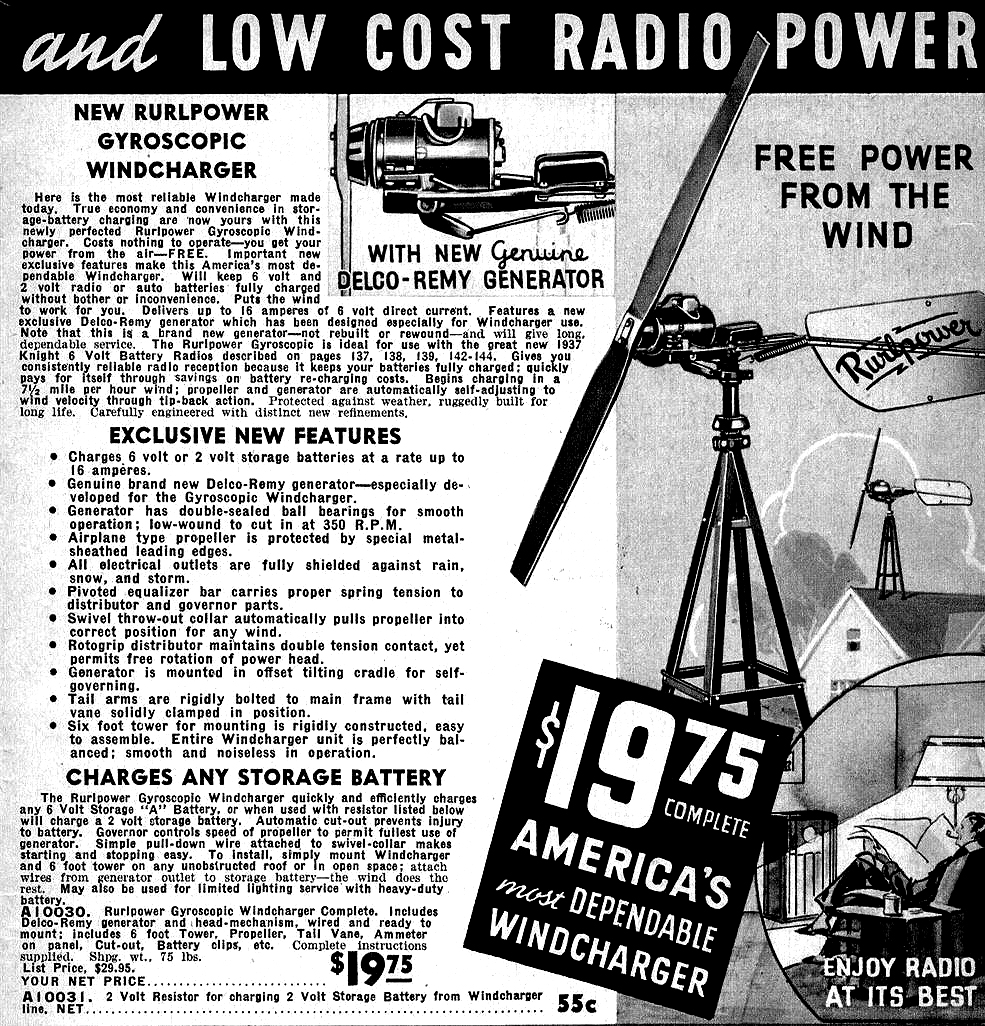

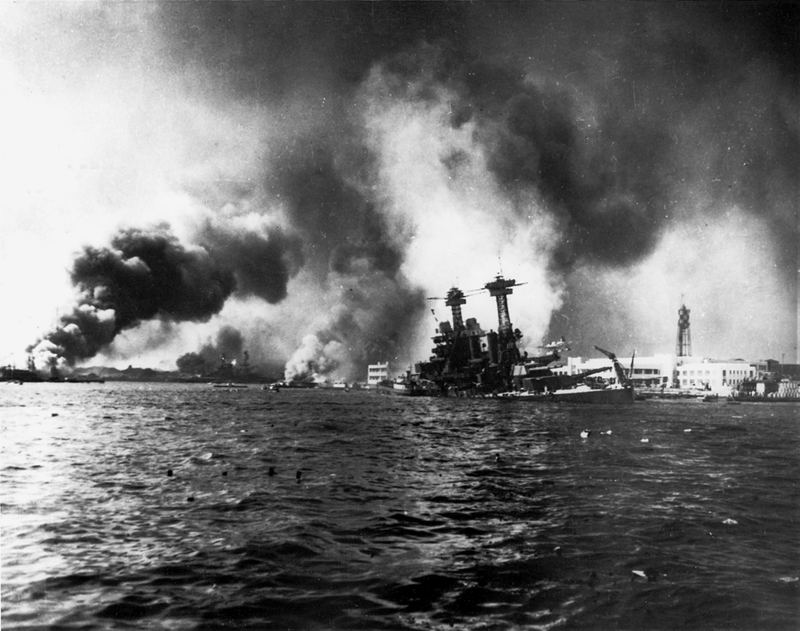
THE JAPANESE ATTACK ON PEARL HARBOR NAVAL BASE, HAWAII, DECEMBER 7, 1941
 |
As the Great Depression was winding down and Americans were again seeing prosperity on the horizon, a new concern was now on the minds of people. An evil power had risen to world prominence in Europe as Nazi Germany sought to conquer and enslave the "free world." Americans were becoming increasingly wary in fear that the United States would eventually have to come to the rescue of European countries that were falling to Hitler's advancing warriors. Just as they had in the Depression years, Americans turned to their radios as a source of world news. By 1940, Radio broadcasting had expanded its horizons around the world, and the listening audiences saw the emergence of a new radio phenomenon, the "traveling journalist." From that era came some of America's greatest newsmen. Edward R. Morrow, John Charles Daly, Alex Dreier, H.V. Caltenborn, Lowell Thomas and Walter Winchell were only a few of the esteemed newsmen who began their careers in this trying period of American history. In December of 1941, the Japanese bombing of Pearl Harbor brought the United States into that inevitable European war, as well as into war with the Empire of Japan. America quickly mobilized to defend itself, and its allies, and all manufacture of radios and electronic equipment, not intended for military use, ceased so that manufacturing plants and facilities could aid in the war effort. |
RADIO PROGRAMMING BEFORE, DURING AND AFTER WORLD WAR II
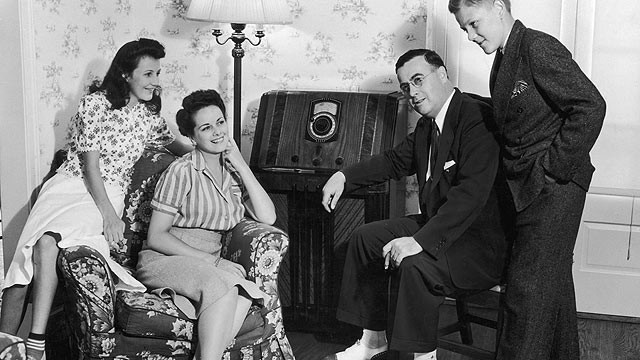
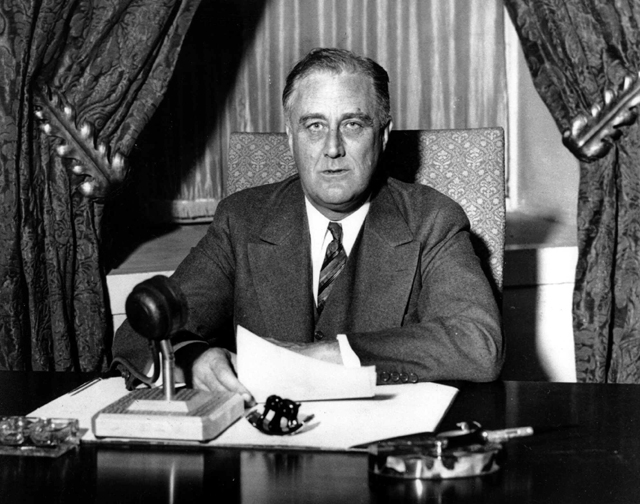
President Franklin D. Roosevelt and the Fireside Chats
THE 'WAR' BEFORE THE WAR
Radio had truly found its niche in the American lifestyle. What once was a whimsical entertainment device, now was being relied upon to keep its listeners informed of life changing real world events. If anyone in the broadcast industry at the time had doubts as to how deeply Radio affected the lives of Americans, an experiment conducted by a young actor of the time, would serve to prove just how powerful a communicator Radio was.
|
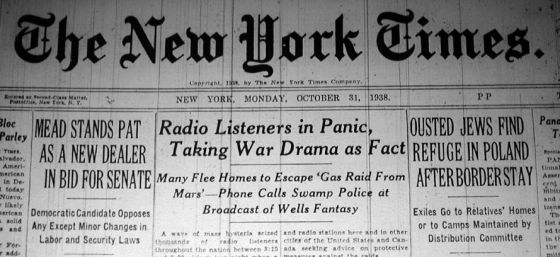 |
In late October of 1938, actor Carl Van Vechten, better known to most by his stage name, Orson Wells, set out to prove his own theory as to just how powerful the medium of Radio was. On Sunday night, October 30, 1938, as war wary Americans were preparing for their annual dose of Halloween trickery at the hands of doorbell ringing youths, Wells aired a radio play on his weekly drama program, "The Mercury Theatre Of The Air," in which he used newly developed techniques unique to the radio news industry to emulate an attack on the world by Martian invaders. Wells recognized that people were now comfortable with placing their complete trust in whatever "news" they heard over the radio. He also recognized that in a world pre-occupied with War, that Radio held the power to be misused as a powerful propaganda weapon. By employing common radio news delivery techniques of the day, such as on-site remote reports, interviews with government officials, and even tapping on the popular Franklin D. Roosevelt "Fire Side Chats," Wells threw the entire United States into a panic by simply adapting a classic H.G. Wells science-fiction novel, and presenting it in such a way as to sound like it was unfolding through a progression of on on-air radio news reports.
The program was not off the air yet when CBS Radio officials began to learn of the havoc that Wells was causing across the country. Persons were fleeing their homes, police and public officials were responding to all-out civil disturbance, and there were even suicides reported as Wells continued to spin his yarn from inside the isolated CBS studio. The consequences were severe as the U.S. Government, and America's citizens now realized the unparalleled power of Radio to influence the minds of its listeners. Wells' purely fictional Mercury Theatre broadcast of the "War Of The Worlds," was directly responsible for untold damage and effect on the lives of his listeners, immediately prompting the broadcast industry to adopt new standards of broadcasting, and the government to conduct Congressional hearings resulting in the creation of more severe Federal Communications Commissions legal regulator as well as broadcast industry sponsored codes of ethics.
Experience a full radio broadcast day in the life of America during World War II with these recorded segments from WJFB, Washington DC.
(Please download files to your computer to listen. Do not attempt to stream)
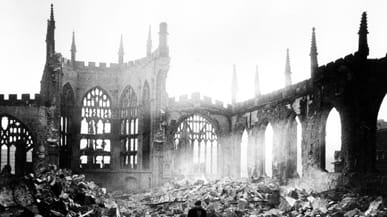 RIGHT CLICK ON EACH ANTENNA GRAPHIC
TO DOWNLOAD CORRESPONDING AUDIO. RIGHT CLICK ON EACH ANTENNA GRAPHIC
TO DOWNLOAD CORRESPONDING AUDIO. PLEASE DOWNLOAD FILES TO YOUR COMPUTER TO PLAY. |
PART 1 (SIGN-ON) |
PART 2 |
||
PART 3 |
PART 4 |
|||
PART 5 |
PART 6 |
|||
PART 7 |
PART 8 |
|||
PART 9 |
PART 10 |
|||
PART 11 |
PART 12 |
|||
PART 13 |
PART 14 |
|||
PART 15 |
PART 16 |
|||
PART 17 |
PART 18 |
|||
PART 19 (SIGN-OFF) |
 |
By late 1945. the War had ended. America and its allies were victorious although most of Europe remained in ruins. As members of our military began to return to civilian life, and families began to deal with the losses suffered by the terrible conflict that had dominated the previous half-decade, the electronics industry began to again produce radios and appliances for the home. The war had brought about many new innovations that could now improve on the products being manufactured, and it was only a matter of months before Americans realized that television in the home would soon be a reality. |

(Service info is available for the above radio. Click the photo to download a PDF file.)
The Bendix Corporation began operations in the early 1900's as a manufacturer of automobile speedometers and accessories. Later, they were instrumental in the War effort as a pioneer in aircraft and bomb navigation systems. After World War II, they licensed the Bendix name to a subsidiary company which found a niche as a manufacturer of home appliances such as washing machines, radios and televisions. While the radio shown above is a much later piece than some of the more rare breadboards and crystal sets in the museum's collection, this Bendix 1949 Catalan radio just happens to be one of the most valuable pieces in our collection. The set was extremely popular in the post-war era, and thus very sought after because of its association with the memories of persons of the "Baby Boom" generation who grew up in the years following World War-II.
A personal recollection from museum founder and chairman John DeMajo:
As a child of that post-war era, I was always impressed by the quality of station break announcements, particularly those of the local stations. Today, we are bombarded with generic station break ID's along the lines of "Q-95FM" "Cool 104" and "Rockin' Oldies 107.3," but back in the days of quality radio, station ID's were spoken by perfectly dictioned studio announcers who emitted phrases along the lines of: "You are tuned to WWL- New Orleans, Loyola University of the South, with studios in the Roosevelt Hotel. Naval Observatory time is 6:PM as we join the Columbia Broadcasting System."
While today's instant-gratification audiences would consider these practices a waste of air time, I am glad that I had the opportunity to come up in an era when big broadcasting conglomerates hadn't yet polluted the air waves with their "one size fits all" radio content. I much prefer those station breaks of old when both networks and local stations took pride in the quality of their product.

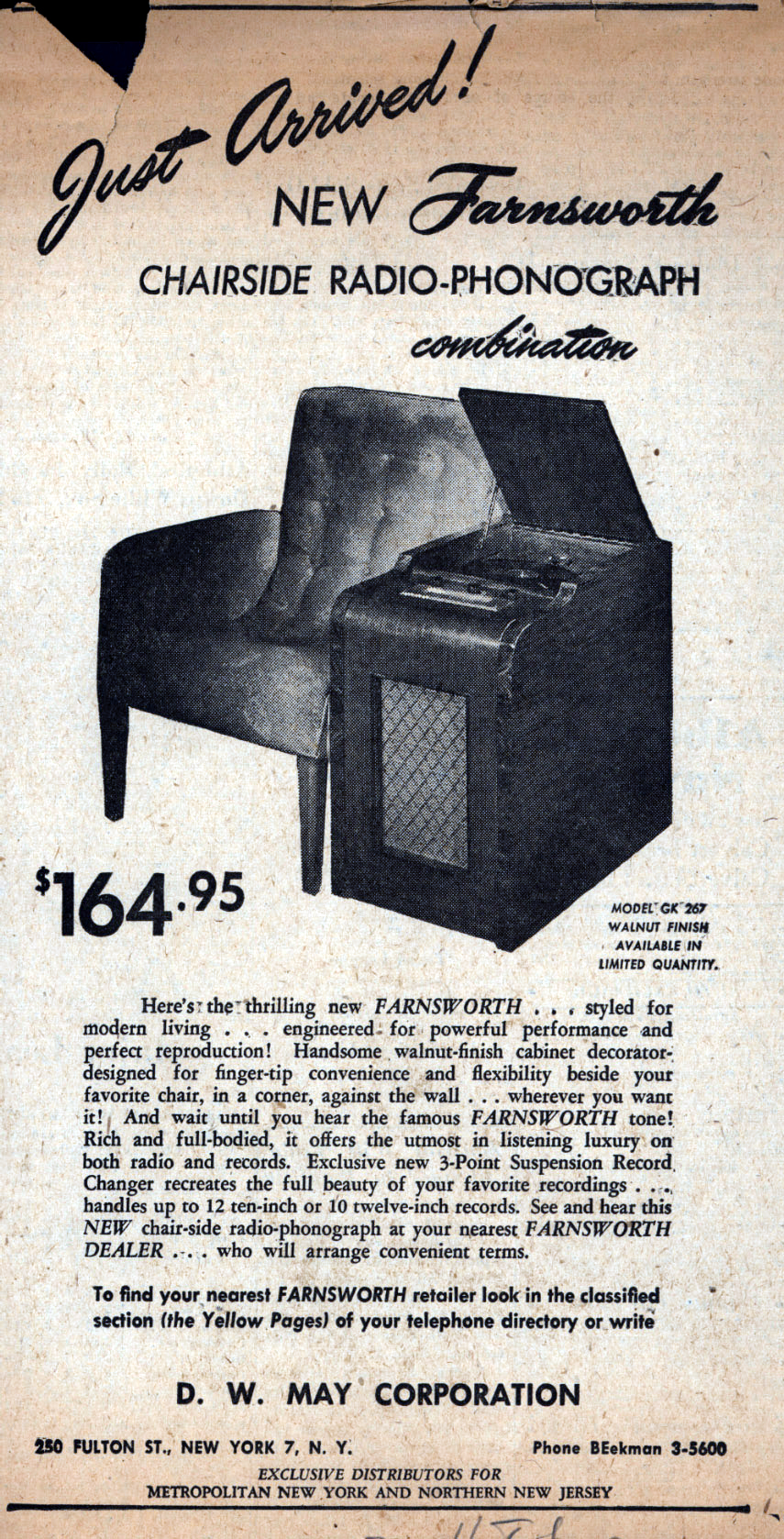 |
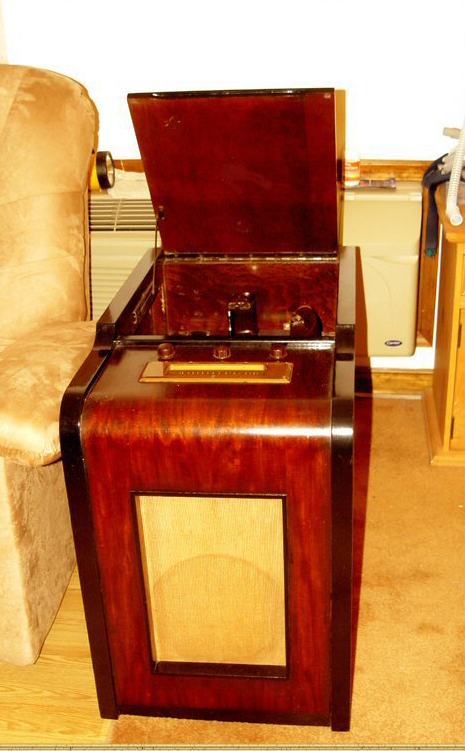 |
A personal recollection from museum founder and chairman John DeMajo:
This is a Farnsworth "Chair side" radio-phono Model GK-267 dating to the late 1930s. My parents' first radio, in our home when I was a child, was an identical set to this one. It was purchased by my grandfather in 1939 and then passed down to my mother and father when they married and moved into their own home at the end of World War II.
In the approximately five years between the time I was born and the purchase of our first television set in the early 1950s, this radio provided our "prime-time" family entertainment each evening between dinner and bedtime. In that pre-television era, we thrilled to programs like Mr. Keene, Dr. Christian, Life With Luigi, The Kraft Music Hall, The FBI in Peace and War, The Beulah Show, and all those great old shows from the late '40s. I credit my love for vintage radios and old radio programs to those formative Post WW-II years spent with my family in front of the "old Farnsworth." __________________________________________________________________________________________________
Farnsworth radios were manufactured by a company founded by scientist and inventor Philo T. Farnsworth. Farnsworth, a graduate of Brigham-Young University, was a noted physicist, and was actually the person who developed the television camera tube and the technology to make fully electronic cathode ray based Television possible. While Farnsworth was more successful in defending his patents than were other early radio pioneers such as Major Edwin Armstrong, many of his 165 patented inventions were constant infringement targets for David Sarnoff and his wealthy RCA empire. Later in his life, Farnsworth moved into the field of nuclear physics, and he is credited with the development of an early nuclear-fission reactor. The photo below shows Farnsworth at work in his laboratory with the development of magnetic deflection of the electron beam in a cathode ray tube.
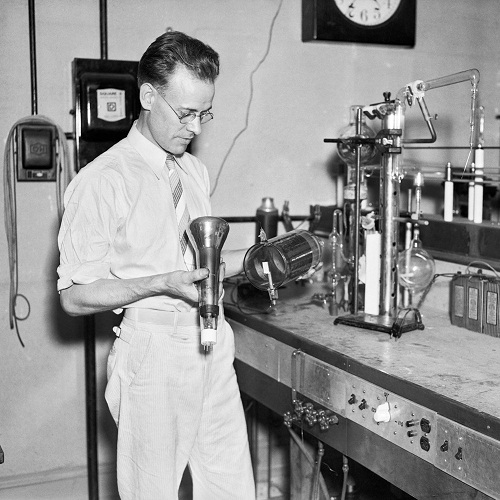



The end of World War II brought on a desire for small and inexpensive AC-DC radios which could be conveniently used in any room of the home. This Philco Transitone Model 50-526 is an example of a popular post War "All American 5" budget radio.
At the end of the WW-II manufacturing blackout, Philco, which began as the Philadelphia Storage Battery Company, was one manufacturer that quickly regained fair market share of consumer radio sales. The"Transitone" name originally belonged to an unrelated company, Automotive Radio, which began producing car radios in the 1920s. Philco acquired Transitone in the early 1930s, but did not use the name until after WW-II. At that time, the Transitone designation was relegated to a budget (cheap) line of home radios. Philco continued to use the Philco name on their higher end entertainment devices, and on their automotive radios. Toward the end of Philco's existence, they were acquired by Ford Motor Company. Click on the photo above to see a short video of the radio following restoration.
 |
E. H. SCOTT RADIO LABORATORIES "The Stradivarius Of Radio Receivers" |
In most industries in the United States "Industrial Age," one or two companies always prevailed as the largest or the best in the field. For example, despite thousands of companies entering the electrical equipment manufacturing field, none have ever approached the prominence of General Electric or Westinghouse. In the radio manufacturing sector, names came and went from the the days of the crystal set, forward. The philosophy of success also changed with the times. In the height of the Great Depression, Atwater-Kent dominated the field because that company sought to meet the need for a good quality, easy to use yet low cost radio for the home. Despite sounding like a fool-proof approach to radio marketing, Atwater-Kent literally put themselves out of business eventually because they built a radio that never failed, hence the purchaser was seldom if ever a "return customer." While some manufactures realized this and thus took on a "planned obsolescence" mentality, one company refused to bow to that business ethic.
Ernest Humphrey Scott (1887-1951) was one such entrepreneur. Scott was born in New Zealand, and he came to the United States after World War I. Settling in Chicago, Scott wrote newspaper columns on radio construction. Over the years, he had experimented with thousands of manufacturing methods and technological advances, which gave him a knowledge of radio far beyond the average designer.
Scott designed a receiver in 1924 that proved to have extraordinary sensitivity and noise reduction. He proved this on a trip back to his native New Zealand where he established a dialog with several radio stations in the USA, proving that he could hear their broadcasts almost as local stations. By 1935, Scott had established himself in the radio business as a builder of "custom built" receivers. His radios were recognized as superior to most brands and his customers included such critical listeners as Arturo Toscanini, Frank Lloyd Wright, Guy Lombardo, Walter Winchell, Deems Taylor, Kirsten Flagstad, Jascha Heifetz, Eugene Ormandy, Enzio Pinza, Lily Pons, actor Robert Montgomery, among others.
The 1930s were the best production years for Scott's home receiver market, although his company developed war-time receivers which were purchased by military and shipping interests during World War II because of their low noise and radiation, which made their presence far less traceable by enemy RF scanners. Features of Scott's consumer radios included all chrome plated chassis and components, separate high-fidelity audio amplifiers, theatre grade speaker systems, and careful attention to quality construction, cabinetry, and durability. Like the Rolls-Royce of that era, the E.H. Scott radio was the finest that money could buy. In 1935, at the height of the Great Depression, a Scott receiver sold for an unprecedented $200. By today's currency standards, that would amount to almost $4000. Following World War II, a Scott console home radio retailed for $1500, and today, vintage restored Scott radios have been sold for upwards of $10,000 on the auction market.
Unfortunately, after great success through the 1930's and the War Years, the company began a downward spiral in the late 1940s. By 1950, Mr. Scott had been eased out of his leadership role in the company, and the later sets did not command the public respect that the earlier sets had. Problems were also experienced by customers who attempted to get local repairs, as many of the local service shops around the country, with which Mr. Scott had built relationships over the years, were now moving on to television service, and therefore gave up their exclusive arrangements with the new and more difficult management of the Scott Laboratories firm. It soon became apparent that there was a service and support void in many previously supported markets, which eventually lead to the company's demise.
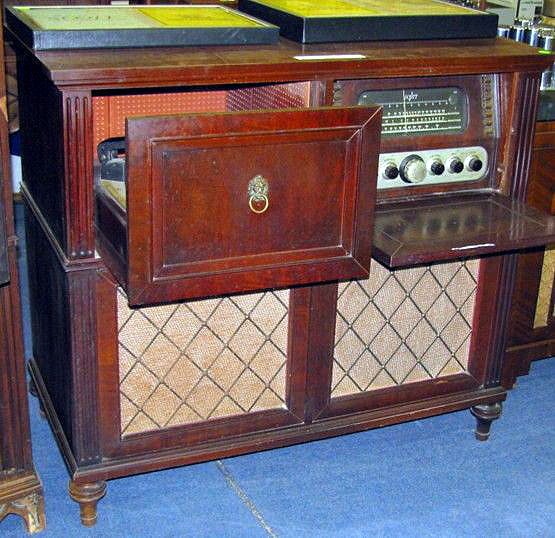
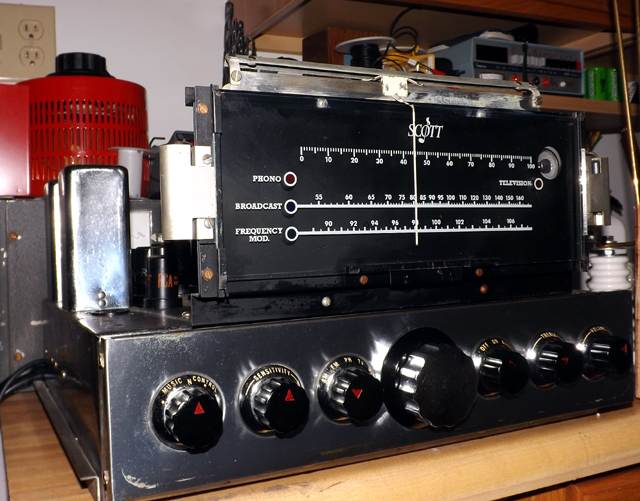
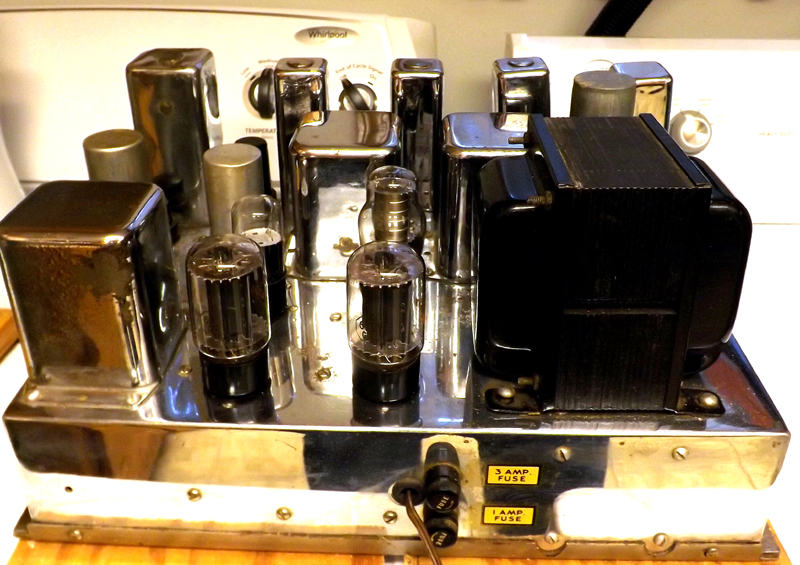
A personal letter to a potential customer, written in 1935, by E. H. Scott

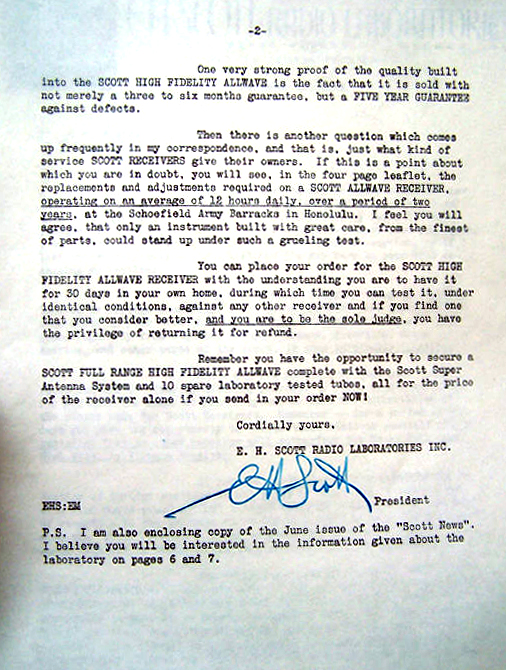
From the 1920's forward, as radio became a fixture in the American home, several companies which operated merchandise outlets unrelated to Radio, began to offer radios made by third-party suppliers. A number of familiar name department stores and auto service companies contracted with radio manufacturers to offer their own branded radio receivers and products. Here is a listing of some of the common brands of third-party marketed home radios sold in the "golden era" of Radio. |
|
RADIO BRAND NAME |
COMPANY WHICH MARKETED BRAND |
| AERIOLA | RCA / WESTINGHOUSE |
| AETNA RADIO | WALGREEN DRUG COMPANY |
| AIR CHIEF | FIRESTONE TIRE AND RUBBER CO. STORES |
| AIRLINE | MONTGOMERY WARD DEPARTMENT STORES |
| DELCO | GENERAL MOTORS CORPORATION |
| GOODYEAR | GOODYEAR TIRE AND RUBBER COMPANY |
| GRANTLINE | W.T. GRANT DEPARTMENT STORES |
| HOTPOINT | GENERAL ELECTRIC COMPANY |
| KNIGHT | ALLIED RADIO CORPORATION |
| PHILCO | FORD MOTOR COMPANY |
| SILVERTONE | SEARS-ROEBUCK AND COMPANY |
| TRUETONE | WESTERN AUTO STORES |

This 1948 Zenith Model 7H820 is of interest because it was made at the time when the Federal Communications Commission was deciding on the final location of the FM radio band. Edwin H. Armstrong had previously obtained permission to use the 50-54Mhz band as the standard for the new FM broadcast technology. His company was licensing and manufacturing radios to receive his pioneer FM station located in Alpine, New Jersey. Since this essentially gave Armstrong's company the exclusive patent rights to FM, David Sarnoff of RCA is said to have wielded his political influence with the government to have the FM band moved to 88-108Mhz, which effectively put Armstrong out of business and prompted him to commit suicide by jumping from an eighth floor window to his death.
The radio above is of note because it is one of a limited number of sets made that had provision for both the 50 and 88 Mhz bands, as the industry waited for a final decision from the FCC. These sets were often referred to as "Armstrong Radios."

THE GREAT ERA OF NETWORK AM RADIO BROADCASTING
COMES TO AN END
AM Radio now caters to Rock N' Roll DJ's and local news reports:

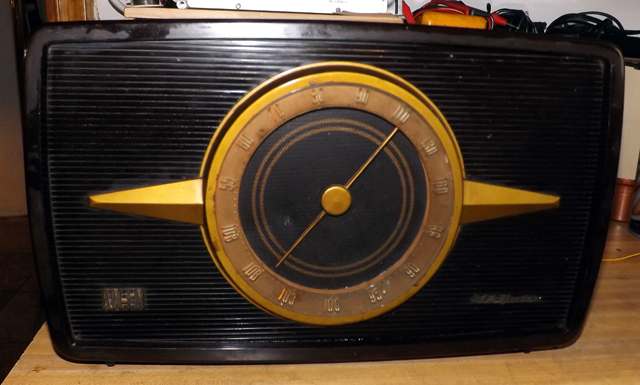
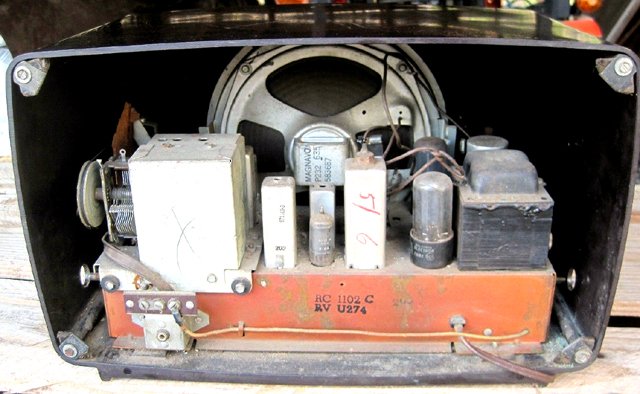
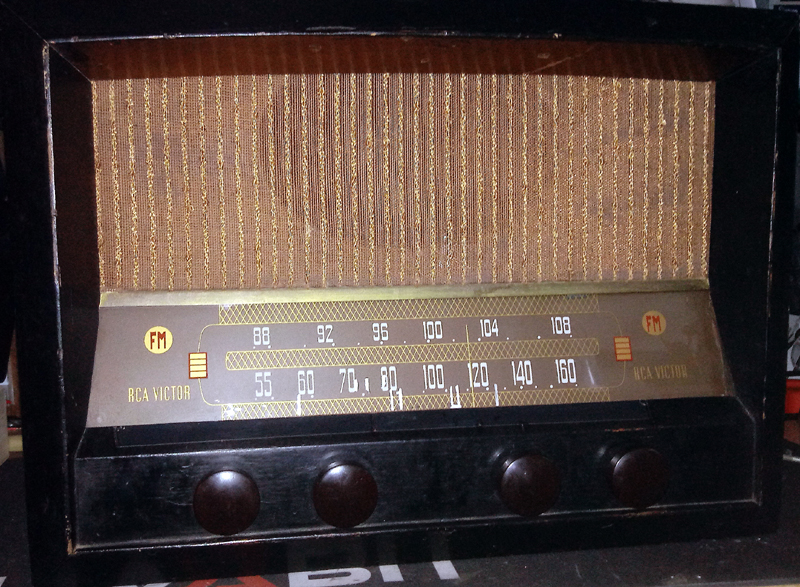
The RCA Model 1R81 "GOLDEN THROAT AM-FM RECEIVER, shown above, was one of the last vacuum tube based receivers produced by the prestigious Radio Corporation of America. Following RCA chairman David Sarnoff's successful campaign to have the FCC abandon the 50Mhz FM band, a move intended to destroy Major Edwin Armstrong's hold on the FM patents and spectrum, RCA began to produce a line of high quality AM-FM receivers that utilized the newly allocated 88-108Mhz. band. In that same era, high fidelity, and then Stereophonic broadcasting technology had also been introduced in experimental form, and this new realism of sound that FM's wider bandwidth allowed, prompted radio engineers to anticipate a need for high fidelity audio systems that could reproduce multi-channel sub-carrier signals. The first experimental Stereophonic broadcasts were specially scheduled and highly advertised "simulcasts" between television and FM radio where one channel of the stereo signal would be received by the television, and the opposite channel would be carried by a high-fidelity FM radio station. This further opened the market for these high-end FM table radios with their superior sound.
By the latter half of the 1950s, a revolution in programming was also emerging. The handwriting was on the wall, so to speak, in that the broadcasting industry saw rapidly declining numbers of live network radio listener ship due to the new popularity of Television. At the same time, Bell Laboratories invention of the Transistor, gave promise that vacuum tube based electronic equipment would soon be a thing of the past. Television receiver prices dropped from a thousand dollars in 1948, to a few hundred dollars by the end of the 1950s, so almost every home could afford to have a television receiver. The industry also saw the approach of stereophonic broadcasting, and local stations and networks soon became aware that FM would become primarily a music service, whereas AM radio would be relegated to news, "top 40" disk jockey programs, and eventually talk radio.
It was in this era that NBC introduced its MONITOR weekend radio service. MONITOR was an experiment intended to appease those avid AM radio listeners who were displeased and disappointed with the recent terminations of network radio shows that they had enjoyed for decades, but more importantly was used to gauge the acceptance of a talk variety format that was far less expensive to produce than the scripted shows it replaced. By 1960, most AM broadcasting originated in local station studios, with a few exceptions such as daily broadcasts of Don McNeill's Breakfast Club, Arthur Godfrey's morning show, a few early evening news casts such as the Lowell Thomas and Bob Considine news shows, and NBC's MONITOR being the final hold-outs that ran well into the 1960s.
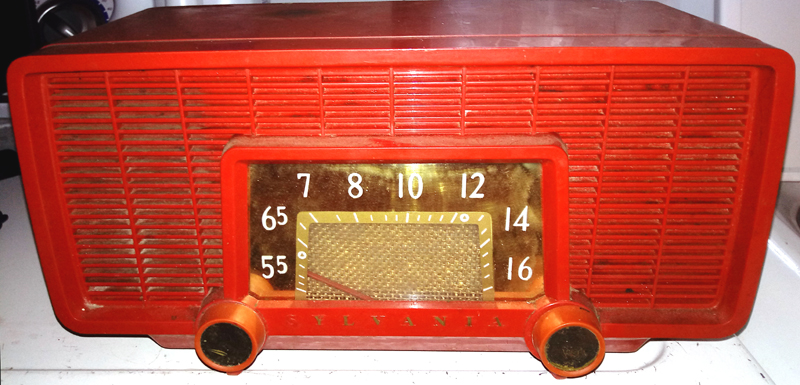
 |
Did you ever wish that you could listen to those recordings of great authentic old radio shows on your antique radios? Well now you can do just that by building the low power wireless AM broadcast transmitter designed by our founder and chairman. Just click the button below to see a complete step-by-step article on building your own low power AM radio station.
|

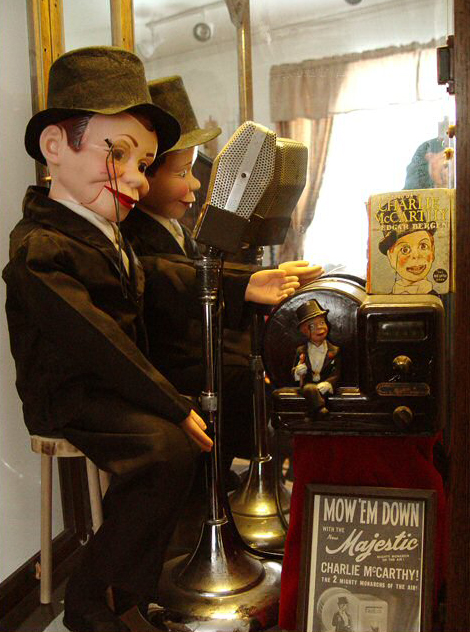 |
Charlie McCarthy ventriloquist dummy along with a vintage RCA 44-Junior microphone, related period memorabilia, and an original and fully restored 1930s Majestic Charlie McCarthy novelty collector's radio. Charlie McCarthy, along with his creator, Vaudevillian Edgar Bergen, became popular in the 1930s when they hosted "The Chase and Sanborn Hour," a weekly radio comedy and variety show presented by the makers of Chase and Sanborn Coffee. |
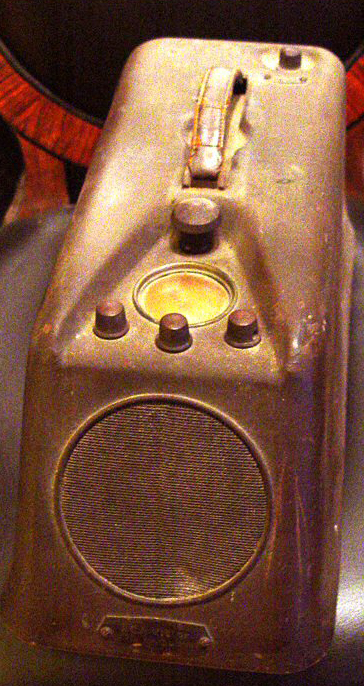

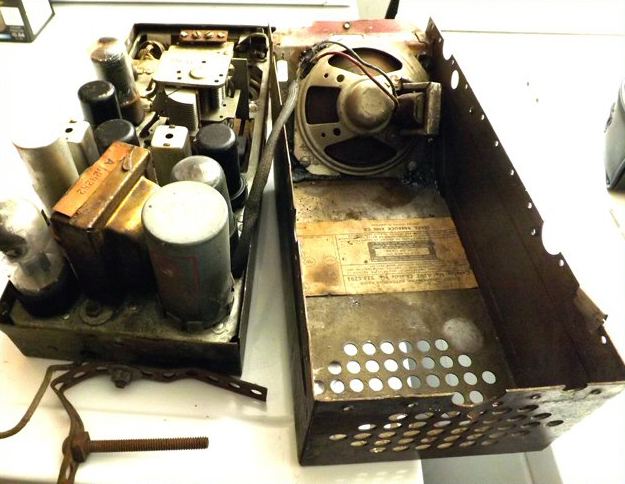

This 1950s Knight-Kit "Ocean Hopper" three-tube kit receiver from Allied Radio Corporation, Chicago 80, IL, was a gift from my grandfather on my twelfth birthday. My seventh-grade Catholic school teacher at the time, Sister Joseph Louise, had me perform the assembly of the kit as part of a week-long project in science class. After the radio was finished, I spent many satisfying hours listening to the last remaining embers of the big network radio show era. "The Amos n' Andy Music Hall," "Yours Truly-Johnny Dollar," "Suspense," and broadcasts of Jan Garber's orchestra from the Blue Room of the Roosevelt Hotel in New Orleans were the evening's typical program lineup in the late 1950's. My receiving antenna was a long wire that was strung between my mother's back yard clothes poles. It was on this set that I heard the final Amos n' Andy broadcast on CBS the night that Freeman Gosden and Charles Correll officially retired from show business.
This was a sad era for long-time radio listeners as it was the period when the major networks ceased production live radio shows. Radio then became a wasteland of screaming disk jockeys who played phonograph records throughout the broadcast day.

As touched upon in the museum's toy collection display, scientific toys were extremely popular in the years following World War II. By the mid-1950s, most homes in the United States had at least one television receiver, and typical televisions were large and heavy enough to require repair in the home. A network of thousands of independent repair shops as well as manufacturers' service divisions, routinely sent technicians into the home to perform appliance service. One such company, RCA Service Division, began marketing an item aimed at inquisitive children who showed interest in the work that the technician was performing. When a child asked questions or wanted to watch the technician work, the child's parents would be offered an opportunity to purchase a $4.95 kit that allowed the child to build a working one-tube radio, while at the same time teaching the child basic electronics involved in its operation.
With the demand from a generation of now science-savvy children, there were a number of other companies who began marketing simple crystal sets and radios as "science projects" and toys for holiday giving. Below are some examples:
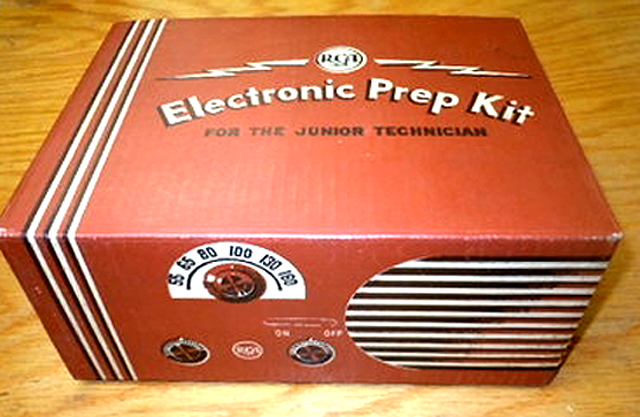
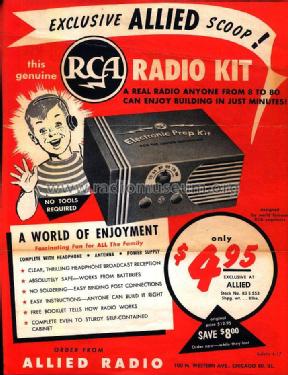
Example of an RCA Electronic Prep Kit In Box.
Our museum founder, John DeMajo, was one of those fortunate children who received an RCA"prep kit"during the mid 1950s. The remains of the kit, which had deteriorated to some extent due to its almost seventy year age, has been restored to allow visitors to experience the constructed radio.
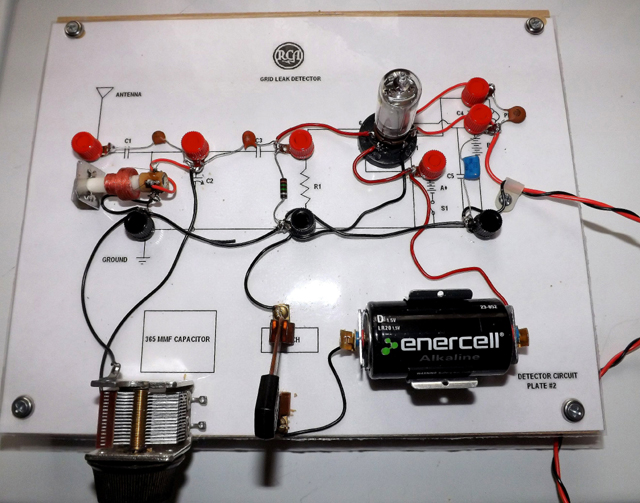

(photo courtesy of Google Images)
Words to “RADIO”
Bob Marcus
Peter Dean
Radio ...
Remember radio?
We'd sit and close our eyes and use our imagination.
Comedy, mystery, a Fireside Chat ...
Together we sat, listening madly to our favorite show.
Radio ...
Why did you ever go?
Oh, won't you please come back and entertain us?
I long to turn that dial again
And hear the past and smile again -
Radio ... I miss you so.
Major Bowes
("Alright, alright ...),
I miss "the Shadow knows"
("Hm hm hah hah haaaah"),
The "Allen's Alley" folks
("Mr. Allen, Mr. Allen ...",
The laughter from "Duffy's Tavern"
("Duffy's Tavern, Archie speakin'"),
"Helen Trent" - then we went to "Can You Top This?"
"Suspense" on the Worst List
Would send those shivers up my spine.
"Uncle Don"
("Hi there, boys and girls ..."),
I wish he was still around
("That'll take care of those little [beep]"),
"Jack Armstrong", "Myrt and Marge", "Amos and Andy",
("Holy Mackerel there, Andy!") ...
I long to turn that dial again
To hear the past and smile again -
Radio ... I miss you so.
(Transcribed by Lou Rugani - The Music of the Stars (WLIP) - April 2011)


